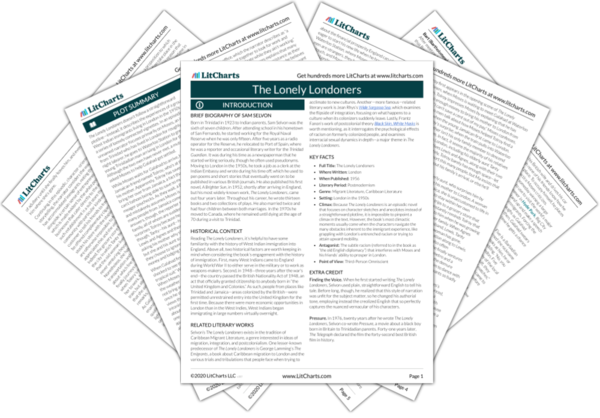Welcome to the LitCharts study guide on Sam Selvon's The Lonely Londoners. Created by the original team behind SparkNotes, LitCharts are the world's best literature guides.
The Lonely Londoners: Introduction
The Lonely Londoners: Plot Summary
The Lonely Londoners: Detailed Summary & Analysis
The Lonely Londoners: Themes
The Lonely Londoners: Quotes
The Lonely Londoners: Characters
The Lonely Londoners: Symbols
The Lonely Londoners: Theme Wheel
Brief Biography of Sam Selvon

Historical Context of The Lonely Londoners
Other Books Related to The Lonely Londoners
- Full Title: The Lonely Londoners
- Where Written: London
- When Published: 1956
- Literary Period: Postmodernism
- Genre: Migrant Literature, Caribbean Literature
- Setting: London in the 1950s
- Climax: Because The Lonely Londoners is an episodic novel that focuses on character sketches and anecdotes instead of a straightforward plotline, it is impossible to pinpoint a climax in the text. However, the book’s most climactic moments usually come when the characters navigate the many obstacles inherent to the immigrant experience, like grappling with London’s entrenched racism or trying to attain upward mobility.
- Antagonist: The subtle racism (referred to in the book as “the old English diplomacy”) that interferes with Moses and his friends’ ability to prosper in London.
- Point of View: Third-Person Omniscient
Extra Credit for The Lonely Londoners
Finding the Voice. When he first started writing The Lonely Londoners, Selvon used plain, straightforward English to tell his tale. Before long, though, he realized that this style of narration was unfit for the subject matter, so he changed his authorial tone, employing instead the creolized English that so perfectly captures the nuanced vernacular of his characters.
Pressure. In 1976, twenty years after he wrote The Lonely Londoners, Selvon co-wrote Pressure, a movie about a black boy born in Britain to Trinidadian parents. Forty-one years later, The Telegraph declared the film the forty-second best British film in history.







